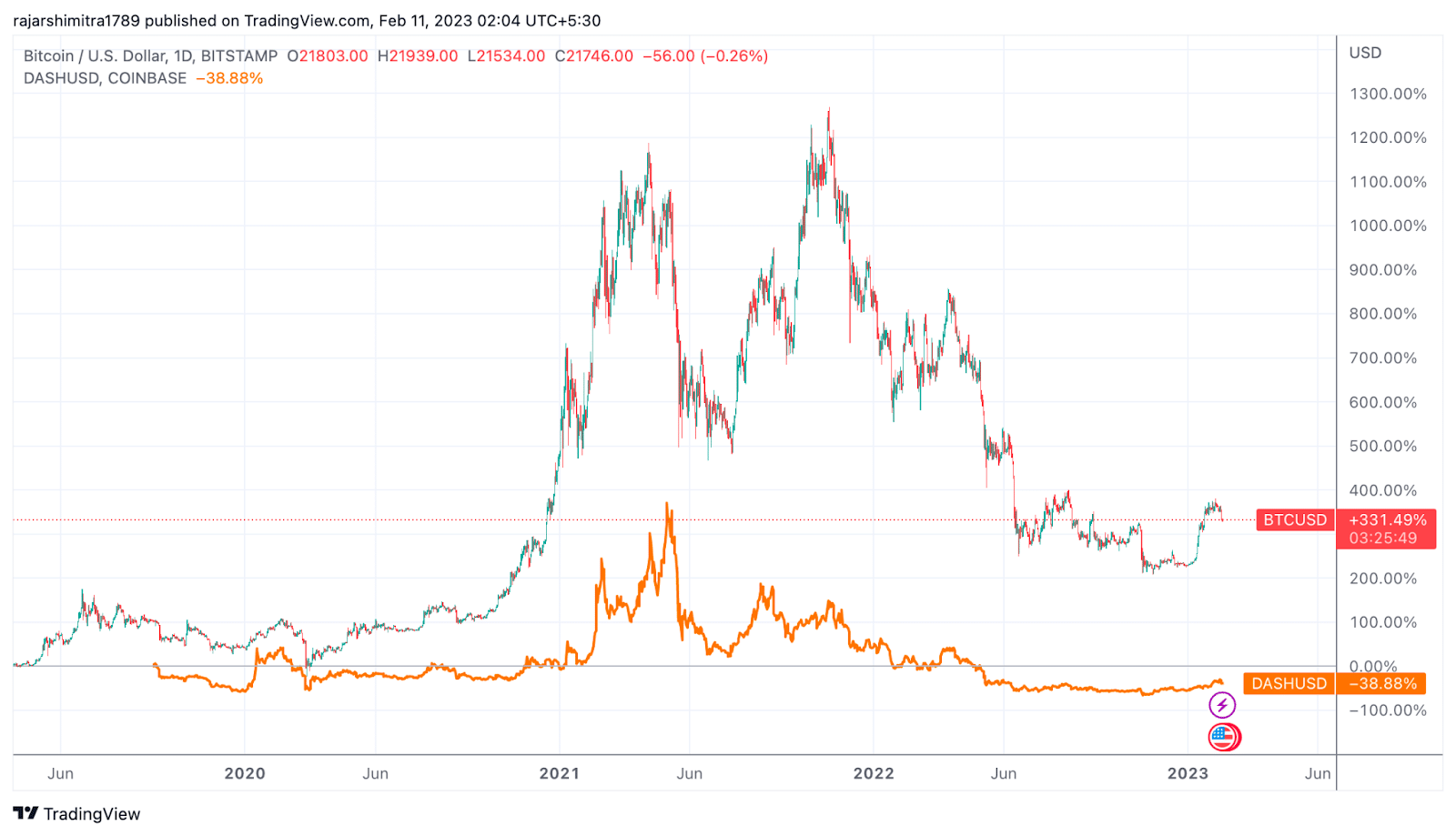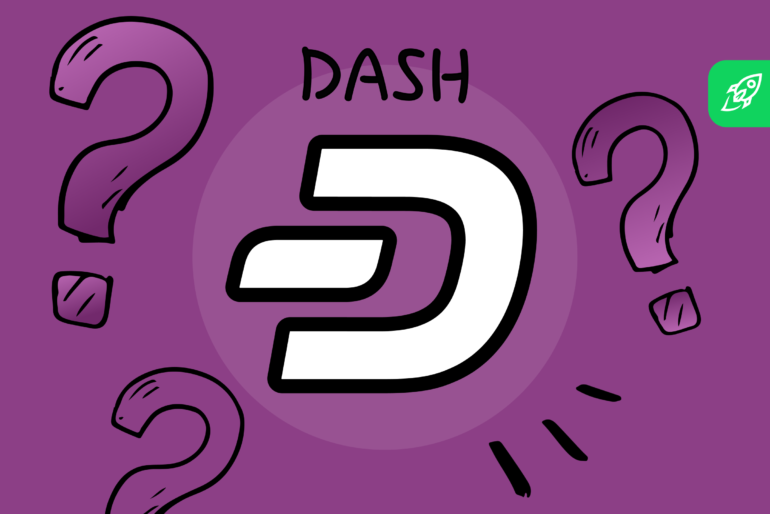beginner
Cryptocurrencies have become a hot topic in the world of finance, with Bitcoin being the most well-known. However, there are many other cryptocurrencies out there, each with its own unique features and benefits. Dash is one such cryptocurrency that has been making waves in the industry.
In this article, we will take a closer look at Dash, exploring what it is, how it works, and what makes it stand out from the crowd. Whether you’re a seasoned cryptocurrency investor or a beginner, understanding Dash is essential if you want to stay ahead of the game. So let’s dive in and discover everything you need to know about this exciting cryptocurrency.
What Is Dash Crypto?
Dash (DASH) is a cryptocurrency that was launched in 2014 by Evan Duffield. Its origin can be traced back to Bitcoin, as it was initially intended to be a more privacy-focused version of Bitcoin. Its name originally came from “Digital Cash” but later rebranded to just Dash.
Similar to most cryptocurrencies, Dash is based on blockchain technology — a secure and decentralized ledger that records all transactions made on the network. However, Dash uses a unique algorithm called X11 that differentiates it from other cryptocurrencies like Bitcoin and Monero.
In comparison with Bitcoin, Dash promises faster transaction confirmation times and lower transaction fees thanks to its Masternode network. Masternodes are dedicated servers on the Dash network that perform advanced functions to verify transactions, enabling the InstantSend feature, which allows for near-instant transactions. PrivateSend is another feature of Dash that enables users to achieve greater anonymity in their transactions.
While Bitcoin transactions are not completely anonymous, Dash’s PrivateSend allows its users to protect their identity and keep their transactions confidential. PrivateSend uses a coin-mixing service where it mixes coins belonging to different users to make it harder to track specific transactions back to individuals.
Dash also has a limited supply of 18.9 million coins. This measure is aimed at boosting the value of the coins in circulation.
In addition, Dash has established partnerships with several payment processors over the years, making it easier for merchants to accept Dash as a form of payment. One of the most notable partnerships is with Bitrefill, a popular online retailer that accepts cryptocurrencies as payment.
Who Created Dash?
Dash was founded by Evan Duffield in 2014 as Bitcoin’s hard fork. Duffield was introduced to Bitcoin in 2010 and was immediately interested in the potential of this innovative technology. However, Duffield identified a few limitations of Bitcoin, such as its slow confirmation times, easy-to-track transactions, and a lack of privacy features, which led him to create an alternative cryptocurrency called XCoin.
XCoin was later rebranded as Darkcoin to promote its focus on privacy features. In 2015, Darkcoin was renamed yet again — this time, to Dash, short for Digital Cash. This change was intended to heighten the cryptocurrency’s appeal to a wider audience.

Duffield made significant contributions to Dash during its early development stages. He implemented various features such as the Masternode network, InstantSend, and PrivateSend to improve transaction speeds and anonymity. These features gave Dash a competitive edge over other cryptocurrencies in the market.
However, Duffield stepped down as the lead developer in 2017 and handed over the reins to a team of developers to continue the cryptocurrency’s growth and development. Despite no longer being actively involved in Dash, Duffield’s contributions to its creation and early development continue to shape and influence the cryptocurrency’s trajectory.
What Makes Dash Cryptocurrency Unique?
Dash is a privacy-focused crypto that provides unique features to its users.
One of the unique features of Dash is the Masternodes system. To operate a Masternode, a user must possess a minimum of 1000 DASH and provide processing power to the network. The Masternode network helps facilitate InstantSend and CoinJoin transactions that contribute to the allure of Dash in the market. InstantSend ensures that transactions are processed quickly, while CoinJoin provides an extra layer of privacy by mixing multiple transactions into a single one.
Dash also offers DashDirect, a feature that enables users to send and receive payments directly through their mobile phones. Users can utilize DashDirect by scanning QR codes and confirming transactions — the process is easy and accessible to everyone.
Dash uses the X11 algorithm for mining, which makes it faster and more power-efficient than the more commonly used SHA-256 algorithm. The PrivateSend feature facilitates anonymous transactions by mixing multiple transactions using the CoinJoin Mechanism. The algorithm then separates the transactions to ensure the anonymity of users.
Dash has a strong community that supports the adoption of its technology; they have funded many projects to promote Dash applications in real-world situations. These projects include the adoption of Dash as a payment method, the development of new features and software for the platform, and the expansion of its use in emerging markets.
Dash’s adoption rate has been impressive, particularly in Venezuela, where the cryptocurrency has been adopted as a solution for hyperinflation and the lack of reliable banking services. Dash has become a popular payment method in Venezuela: many merchants accept it as a legitimate payment option.
Why Does Dash Have Value?
Dash is a digital currency that has gained popularity and recognition among cryptocurrency enthusiasts. Many wonder why it has value and what makes it worth investing in.
One of the characteristics that give Dash value is its scarcity. The maximum supply of Dash coins is capped at 18.9 million, which naturally encourages high demand. As coins become scarcer, they tend to grow in value over the long term. In addition to scarcity, another valuable characteristic of Dash is its durability. Unlike traditional currencies, Dash coins cannot be destroyed or damaged due to their digital form, which gives them longevity and the ability to maintain their value over time.
Dash’s portability is one of its most compelling features. The currency can be sent and received anywhere in the world at any time without intermediaries or constraints of traditional financial systems. This makes it an attractive option for those who value autonomy and freedom in their financial transactions.
Dash also has a robust and secure masternode network that facilitates fast and cheap transactions. Its InstantSend feature enables instant capital transfers, whereas PrivateSend supports anonymity. This duo comes in handy for users who need quick remittances and prioritize their privacy.
Overall, there are many reasons why users may find Dash compelling. Its practical applications, transaction speed, and security features give it a level of utility and value that is hard to ignore. As demand for Dash continues to grow, its long-term value as a store of wealth becomes clearer. Therefore, users seeking to diversify their portfolio may regard DASH as a viable investment.
Dash vs. Bitcoin
Dash is an exciting cryptocurrency that has been gaining popularity alongside Bitcoin. Like the flagship crypto, it is a decentralized digital currency that can be used for online payments and transfers. While it shares a lot of similarities with Bitcoin, Dash offers some unique features that set it apart and make it an interesting alternative for those looking to invest in cryptocurrencies. In this block, we will explore some key differences between Dash and Bitcoin, including transaction speed, transaction fees, and privacy and security features.

When it comes to price movement, altcoins typically follow Bitcoin, and DASH is no exception. As you can see, there are significant parallels in the daily price patterns. Image source: Dash
Similarities
– Decentralization: Both Dash and Bitcoin are decentralized, meaning they don’t have a central authority controlling them.
– Limited Supply: Bitcoin and Dash have a limited supply of 21 million and 18.9 million coins, respectively.
– Concept: Both cryptos share the concept of a global, peer-to-peer, and trustless digital currency.
Overall, Dash and Bitcoin may seem similar at first glance; however, a closer look proves they have some significant differences. Their similar concepts and limited supplies demonstrate how blockchain technology can provide alternatives to traditional currency. Dash’s transaction speed, affordability, and privacy make it a strong competitor in the cryptocurrency space.
Differences
– Transaction cost: The transaction cost on the Dash network is lower than on the Bitcoin network. Therefore, Dash transactions are more affordable.
– Network control: Bitcoin mining is dominated by only a few large mining pools, while Dash mining is more decentralized, with over 4,000 masternodes controlling the network.
– Privacy: Dash’s PrivateSend feature makes it possible for users to send anonymous transactions, while Bitcoin transactions can be traced back to their source.
– Mining: Bitcoin uses a proof-of-work (PoW) consensus mechanism, while Dash applies a hybrid consensus mechanism of Proof of Work (PoW) and Proof of Service (PoS).
– Efficiency: Dash transactions are faster, with a block time of 2.5 minutes compared to Bitcoin’s 10 minutes.
– Consensus mechanism: Dash employs a two-tier network to enable speedy and feeless transactions, while Bitcoin relies solely on miners for transaction validation.
To sum up, Dash offers lower transaction fees, a more decentralized network, enhanced privacy features, and a faster consensus algorithm. So, in comparison to Bitcoin, it is a highly efficient cryptocurrency.
Is Dash an Alternative to Bitcoin?
When it comes to alternative cryptocurrencies, there are a few that standout from the rest. Bitcoin may be the original and most popular option, but Dash is quickly becoming a preferred choice for those looking for an improved experience.
For one, Dash’s speed is unmatched by any other cryptocurrency on the market. Transactions can be completed in just 4 seconds, compared to Bitcoin’s average confirmation time of 10 minutes. This makes daily transactions much more convenient for users and reduces the waiting time.
Another comparison that favors Dash is cost. When converted to fiat currency, Dash costs considerably less than Bitcoin does. For example, at the time of writing, 1 DASH equals $44, while the price of 1 BTC is around $27,500. As a result, it may be easier for the public to adopt Dash and find applications for its unique features.
Finally, what favorably differentiates Dash from other cryptocurrencies is its governance model. Unlike Bitcoin, which is controlled by a single entity (The Bitcoin Foundation), Dash is governed by a group of volunteers who constantly work to improve the network. This gives users more control over their money and allows them to support projects they believe will benefit them in the long run.
What Is the Future of Dash?
Related: DASH coin price prediction
Dash is undoubtedly one of the leading players in the digital currency industry and a real scene-stealer: its numerous features (e.g., InstantSend and PrivateSend payment systems), as well as self-governing and self-funding mechanisms, are worth attention. Additionally, its total supply of 18.9 million coins is much lower than Bitcoin’s, which may result in an increased demand for Dash. Furthermore, as more and more people are drawn to digital currencies due to their convenience and economic instability in many countries, Dash stands out as a viable option that could be utilized by millions of people outside the traditional banking system.

Given all this, it is likely that Dash will play an increasingly important role in the crypto world over the next few years. If things go according to plan for the currency, it may even catch up to some of its former peers that currently have bigger market capitalization. Moreover, if developed countries start introducing regulations that simplify the usage of cryptocurrencies through systems like Paypal or other online checkout processes, then we might see a rise in demand for Dash. After all, it already has an established infrastructure and market presence. All this leads us to believe that Dash may hold greater potential in terms of future growth and value appreciation.
The Bottom Line
In conclusion, Dash’s unique features and growth potential helped it prove itself as a strong contender in the world of cryptocurrency. Even though there are some risks associated with its anonymity and lack of full decentralization, Dash looks like a promising option for online payments.
One of the especially enticing aspects of Dash is its optional PrivateSend and InstantSend features. PrivateSend allows users to keep their transactions anonymous, while InstantSend provides lightning-fast transactions. Considering Dash’s speed and low transaction fees, this crypto could be a practical choice for those who appreciate efficiency and affordability in their digital transactions.
Based on Dash’s historical price patterns and increasing adoption in economically unstable countries, it is possible that this cryptocurrency will continue to see growth in the coming years. However, as with any investment, there are no guarantees, and it is important to stay informed and make wise decisions. Overall, Dash is a valuable option for those seeking an innovative and efficient way to handle online payments.
Disclaimer: Please note that the contents of this article are not financial or investing advice. The information provided in this article is the author’s opinion only and should not be considered as offering trading or investing recommendations. We do not make any warranties about the completeness, reliability and accuracy of this information. The cryptocurrency market suffers from high volatility and occasional arbitrary movements. Any investor, trader, or regular crypto users should research multiple viewpoints and be familiar with all local regulations before committing to an investment.

